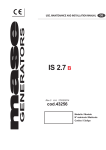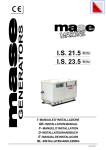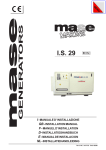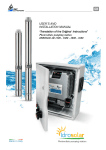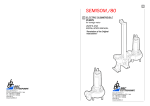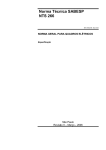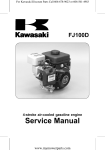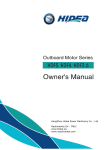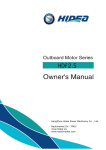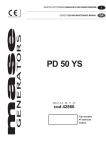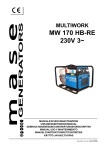Download FM 50H - FM 5.4H FM 80H
Transcript
GRUPPO ELETTROGENO MANUALE DI USO E MANUTENZIONE GENSET USE AND MAINTENANCE MANUAL ELEKTROAGGREGAT GEBRAUCHSANWEISUNG UND WARTUNGSVORSCHRIFTEN FM 50H - FM 5.4H FM 80H - FM 7.5H REV.10 A.A. 19/05/2006 cod.41822 Tipo modello N° matricola Codice I GB D FM 5.0 H - 5.4 H - 7.5 H - 8.0 H A B C D Fig.A E F G N M H I L Fig.1 -2 FM 5.0 H - 5.4 H - 7.5 H - 8.0 H 4 Fig.2 3 1 4 2 Fig.3 1 3 2 Fig.4 -3 FM 5.0 H - 5.4 H - 7.5 H - 8.0 H S.A.E Service Grade 5W 5W30 MAX 10W 10W30 20W 20W40 20 30 -30 -20 40 -10 0 10 20 30 o Ambient temperature ( C) MIN 40 Fig.6 Fig.5 FM 50 H Fig.8 Fig.7 FM 5.4 H - FM 7.5 H FM 80 H Fig.9 -4 Fig.10 FM 5.0 H - 5.4 H - 7.5 H - 8.0 H 5 13 12 14 11 15 9 3 2 4 6 7 8 1 FM 5.4 H MECC.ALTE Cod. 45248 Fig.11 -5 FM 5.0 H - 5.4 H - 7.5 H - 8.0 H 5 13 12 14 11 15 9 3 2 4 6 7 8 1 FM 7.5 H MECC.ALTE Cod. 45247 -6 Fig.12 FM 5.0 H - 5.4 H - 7.5 H - 8.0 H 13 12 10 11 9 3 5 6 4 7 8 1 FM 80 H MECC.ALTE Cod. 45236 Fig.13 -7 FM 5.0 H - 5.4 H - 7.5 H - 8.0 H 13 12 11 10 9 3 5 2 6 7 8 1 FM 50 H MECC.ALTE Cod. 45235 -8 Fig.14 FM 5.0 H - 5.4 H - 7.5 H - 8.0 H 11 13 9 10 12 14 3 5 6 2 7 8 1 FM 50 H Nuova Saccardo Cod. 45631 Fig.15 -9 FM 5.0 H - 5.4 H - 7.5 H - 8.0 H 11 13 9 10 12 14 3 5 6 2 7 8 1 FM 50 H Nuova Saccardo Cod. 45629 - 10 Fig.16 FM 5.0 H - 5.4 H - 7.5 H - 8.0 H GB INDEX PICTURES ............................................................... 2 WIRING DIAGRAM .................................................. 5 DEFINITIONS USED .............................................. 13 1 GENERAL INFORMATIONS .......................... 14 1.1 1.2 1.3 1.4 1.5 1.6 1.7 1.8 1.8.1 1.9 1.9.1 1.9.2 1.9.3 1.9.4 1.9.5 1.9.6 Conform use .................................................. 14 Residual risks ................................................ 14 Symbology, definitions and manual informations 15 Reference documents ..................................... 16 Reference regulations and legislative provisions . 16 Marking ......................................................... 16 Identification of the generator unit ..................... 16 Position of safety labels .................................. 17 Meaning of the safety labels ............................ 18 General danger information .............................. 20 Danger of entanglement .................................. 20 Danger of burns ............................................. 20 Danger of harm to hearing ............................... 21 Danger of intoxication ..................................... 21 Danger of fire or explosion ............................... 21 Danger if failing to use personal protection devices ........................................... 21 1.9.7 Danger caused by the engine starting .............. 22 1.9.8 Danger of electromagnetic radiation ................. 22 1.9.9 Danger of electrocution ................................... 22 1.9.10 Danger resulting from bad storage ................... 22 2 2.1 2.2 2.3 2.4 3 3.1 4 4.1 4.2 4.3 5 5.1 5.2 5.3 5.4 5.5 5.6 5.7 5.8 6 6.1 6.2 7 7.1 7.2 8 8.1 8.2 9 ANOMALIES, CAUSES AND REMEDIES ......... 31 Parts list ........................................................ 31 Rules for ordering spare parts .......................... 31 TRANSPORT, STORAGE, LIFTING AND HANDLING ................................................... 32 Transport and storage ..................................... 32 Lifting and handling ......................................... 32 GUARANTEE AND RESPONSIBILITY .............. 33 Guarantee ..................................................... 33 Limits of responsibility .................................... 33 DISPOSAL ..................................................... 33 9.1 Disposal of the waste materials deriving from maintenance and scrapping ............................ 33 10 SPARE PARTS ORDER FORM ....................... 34 General characteristics ................................. 23 Table of technical characteristics ..................... 23 Noise emission .............................................. 24 Generator composition .................................... 25 Instrument panel ............................................ 25 INSTALLATION .............................................. 25 Positioning the generator ................................ 25 USING THE GENERATOR ............................... 26 Starting ......................................................... 26 Protections ................................................... 26 Stopping ........................................................ 27 CARE AND MAINTENANCE ............................ 28 Preamble ....................................................... 28 Ordinary engine maintenance .......................... 28 Engine oil change ........................................... 28 Spark plug maintenance ................................. 28 Air filter cleaning/replacement .......................... 29 Period of inactivity .......................................... 29 Scheduled maintenance table ......................... 30 Wiring diagram list ......................................... 30 GB - 11 FM 5.0 H - 5.4 H - 7.5 H - 8.0 H GB This manual has to be preserved for all through life of the gen set to which ago reference Thank you for having chosen a product MASE. As a leading generator manufacturer, Mase Generators offers a wide range of generators with an output from 1 KVA portable generators to 1600 KVA units for special applications. Founded in 1970, the Cesena-based company extends over a area of 16,000 square meters, including a 9,000 sq. mtr. manufacturing facility. Mase Generators began as a company producing 500 Watt, light and compact portable generators. These generators made the Mase Generators name well known throughout the world. Mase Generators is a leader in high quality, reliable products, and innovative research performed by Research and Development Department. The generator you have purchased is the fruit of years of experience in the sector and for the modern conception, the strong sizing, the materials employees, the continuous updatings, constitutes an effective answer to the operators’ demands of the sector. This Manual instructions will furnish you useful information and precious suggestions so you can fully exploit all the possibilities that the generators offers you. If any part of the manual resulted incomprehensible, please contact us. In to renew our thanks we cordially greet you. MASE GENERATORS SPA MASE GENERATORS S.p.A. Via Tortona, 345 47023 Cesena (FC) Italy Tel.+39-0547-354311 Fax.+39-0547-317555 Technical data, informations, layouts of the texts and graphic preparations: edited by the Technical Office Mase Generators THE MASE GENERATORS SPA, RESERVES ALL THE RIGHTS ON THE MANUAL PRESENT. ANY TOTAL OR PARTIAL REPRODUCTION IS PERMITTED WITHOUT WRITTEN AUTHORIZATION OF THE MASE GENERATORS SPA. GB - 12 FM 5.0 H - 5.4 H - 7.5 H - 8.0 H GB DEFINITIONS USED The terms used are current technical terms and where considered necessary, the meaning is described below. - Generator An assembly of an internal combustion piston engine and an alternate current, synchronous, 2-4 pole, self-excited generator, joined together to create a station for self-production of electrical energy. - User system Composed of the power supply circuits of the user equipment, including the relevant sectioning, handling, breaking, transformation, protection, etc. devices which do not form part of the production, transmission and distribution systems. - Category 1 electrical system A system where the rated voltage is greater than 50 V and smaller than 1000 V including alternate current. - Load A set of numerical values of electrical and mechanical magnitudes which characterise the requirements imposed on a rotary machine by an electrical circuit or by a mechanical device at a certain instant. - Thermal switch Main cut-out and breaking device made up of a switch which opens automatically by thermal effect. - Differential switch Main cut-out and breaking device made up of a switch which opens automatically by differential current effect. - Skilled person A person with technical know-how or sufficient experience to allow him to avoid the dangers inherent in electricity. - MASE specialised personnel A person able to evaluate the job assigned to him and recognise the possible dangers on the basis of training at the MASE training centres, with professional experience and knowledge of the equipment in question and of the possible dangers deriving in the event of negligent behaviour. - Supplier A body (e.g. manufacturer, agent, installer) which supplies the equipment or services relating to the machine. - Control Control action by which an output variable of the controlled system (controlled variable) is affected by an input variable of the controlling system in order to achieve a certain goal. - Manual control Control where the change of a variable handled is produced by a person through manual intervention - Automatic control Control where the change of a variable handled is produced by a controlling device (automatic controller) without the intervention of a person - Danger Source of possible harm or damage to health - Protection Guard or protection device as safety measure to protect persons from a present or potential danger. - Casing Part intended to assure protection of the equipment against specific outside influences and protection in every sense against contacts. GB - 13 FM 5.0 H - 5.4 H - 7.5 H - 8.0 H GB 1 GENERAL INFORMATIONS 1.1 Conform use The generator is suitable for independent production of electrical energy within the voltage and wattage limits declared by the manufacturer. Any other use outside the already stated field of use is prohibited: the generator is intended for non-industrial use. The generator has been designed to operate independently (without operator) if not for sporadic checks. The limits of use are: -operating temperature: -5° +40° -relative humidity: 30% - 90% -the generator is suitable for operation outdoors provided that it is protected against rain; it may not be operated in closed environments since the generator produces exhaust gas. Inside installation is subject to approval by Mase or an installer authorised by Mase. Arbitrary modifications to the machine are prohibited for safety reasons. Original spare parts must be used on pain of losing machine conformity. All the operations that require dismantling of special parts may only be carried out by technicians authorised by the local dealer or the manufacturer. Only Mase technicians or personnel trained by Mase have the necessary knowledge of the generator and the special equipment as well as the experience to carry out any operation in the most economical and reliable way. 1.2 Residual risks The generator has been designed taking into account the safety regulations set out in the EC directives and standards; nonetheless, the following residual risks remain:The generator has been designed taking into account the safety regulations set out in the EC directives and standards; nonetheless, the following residual risks remain: - injury caused by contact with hot parts during maintenance. injury caused by electrocution during maintenance on the electric panel. risks connected with long periods of exposure to the noise of the generator. risks due to contact with the generator lubricants during maintenance. risks due to the fire hazard the fuel represents. Because of the typical intrinsic danger of the Generators, you are reminded that, although the generator has been designed, constructed and tested in accordance with the safety regulations, only proper and careful use can guarantee full safety; to this end, the various precautions to be taken during use of the Generator are listed below. GB - 14 FM 5.0 H - 5.4 H - 7.5 H - 8.0 H GB 1.3 Symbology, definitions and manual informations Those parts of the text not to be ignored are highlighted in bold type preceded by a symbol, as illustrated and defined below. Indicates that particular attention must be paid in order to prevent running serious risks which could lead to death or possible harm to the health of personnel. A condition which may occur during the lifetime of a product, system or plant considered at risk regarding damage to persons, property, the environment or economic loss. Indicates that particular attention must be paid in order to prevent serious consequences which could result in damage to tangible goods, such as the resources or the product. Instructions of particular importance. Carefully consult this manual before using or carrying out any operation on the generator. FAILURE TO RESPECT THE SPECIFICATIONS CONTAINED IN THIS USE AND MAINTENANCE MANUAL WILL RESULT IN FORFEITURE OF THE GUARANTEE ON THE PRODUCT. This manual was drawn up by the manufacturer and forms an integral part of the generator equipment, definition used as indicated in Directive 98/37/ EC; the information contained in the manual is addressed to all the persons involved in the operating life cycle of the generator, and is necessary to inform both those who effectively carry out the different operations and those who coordinate the activities, to arrange the necessary logistics and to regulate access to the place where the generator will be installed and operated. This manual was drawn up by the manufacturer with the purpose of providing essential information and instructions for proper use and maintenance in conditions of safety. It constitutes an integral part of the generator equipment and must carefully be protected from any agent which may damage it for the entire life cycle of the generator. The manual must accompany the generator if transferred to another user or owner. The manual defines the purpose for which the generator was constructed and contains all the information necessary to guarantee safe and proper use. Constant observance of the instructions contained in this manual guarantees the safety of the operator, protection against damage to persons or things, operating economy and a longer life of the generator. The drawings are provided by way of example. Even if the generator in your possession differs from the illustrations contained in this manual in elements of little significance, for example the colour, the safety of the generator and the information provided are nevertheless guaranteed. To facilitate consultation, it has been divided into sections identifying the main concepts; for a quick look at the topics, consult the index. Ongoing improvement and development of the product may have led to modifications to the generator which are not included in this publication. Whenever a problem concerning the generator or this publication arises, consult with Mase Generators SPA for the latest information available. GB - 15 FM 5.0 H - 5.4 H - 7.5 H - 8.0 H GB 1.4 Reference documents 1.6 Marking The instructions for use provided with each generator are made up of a collection of documents of which this manual represents the General Part. The following documents are normally provided separate. The generator identification plate carries all the identification data in accordance with the provisions for EC marking for those cases where required. Below is a facsimile of the identification plate fixed on the hull of each generator, (Fig.A). a CE declaration of conformity. b Instruction manual for use of the generators, (this manual). c Engine use and maintenance manual. d List of mase Service Centres. e Mase Warranty certificate. f Warranty card. 1.5 Reference regulations and legislative provisions The generator groups, built by mase, destined to the countries of the European Community, are conforming to the applicable EC directives, and they are provided of a EC Declaration of Conformity. 98/37/EC and subsequent amendments: Essential machine requirements for safety and health protection (“Machine” directive). 73/23/EC and subsequent amendments contained in the directive 93/68/EC : Guarantee of safety of electrical material intended for use within certain voltage limits, (“Low Voltage” Directives). 1.7 Identification of the generator unit See Fig.A 1 2 3 4 5 6 7 8 9 10 11 12 13 14 15 16 - Machine name - Machine code - Serial number - Rated power - Declared frequency - Rated power factor - Rated voltage - Rated current - Degree of protection - Class of isolation - Temperature max. of use - Altitude max. of use - Performance class - Year of construction - Manufacturer - Adress - Weight 1 3 2 4 5 6 7 8 9 10 11 15 14 16 12 13 Fig.A The machine code number, the serial number and the year of construction must always be indicated when contacting the manufacturer for information, order of spare parts, etc.. GB - 16 FM 5.0 H - 5.4 H - 7.5 H - 8.0 H GB 1.8 Position of safety labels Cod. 42349 Cod. 42350 STOP Cod. 42346 Cod. 42118 Cod.46106 Cod. 42348 cod. 42112 Fig.14 GB - 17 FM 5.0 H - 5.4 H - 7.5 H - 8.0 H GB 1.8.1 Meaning of the safety labels • These labels warn the user of any danger which may cause serious injury. Carefully read the meaning and the precautions described in this manual. • If the label detaches or becomes illegible, replace it with a new one which can be requested from an authorised Mase dealer. Danger Symbols Meaning - Caution to avoid burns, do not touch during operation. The exhaust manifold and the engine, pay attention to the labels on the generator. - Leave the engine to cool down before storing it indoors. - Read and understand the Use and Maintenance Manual before starting the generator. - The Mase generator has been designed so as to guarantee safe and reliable operation provided that the instructions are followed. Otherwise, personal injury or damage to the equipment may result. - The exhaust gases contain toxic carbon monoxide. - Never operate the generator in a closed space. - Provide for adequate ventilation. If installed indoors, scrupulously observe the ventilation regulations. STOP - The fuels are highly flammable and in certain conditions also explosive. Fill up in a well-ventilated area with the engine off. Do not smoke or create sparks while filling up. Immediately clean off any fuel leaks. - Danger of electric shock: consult the manual. Obligation Symbols Meaning - Obligation to connect the generator to earth. GB - 18 FM 5.0 H - 5.4 H - 7.5 H - 8.0 H GB Prohibition Symbols Meaning - The connections to an emergency electric network must be carried out by specialised electricians in compliance with the relevant regulations in force. Improper connections may cause current feedback from the generator to the electrical lines connected. These current feedbacks may cause electroconduction to the people working for the electricity company or who come into contact with the lines during the failure. Moreover, once the line has been restored, the generator may explode, burn or cause fires in the electrical system of the facility. - No smoking or use of open flames. - Do not clean, lubricate, repair or adjust moving parts. - Do not extinguish fires with water, use homologated extinguishers. GB - 19 FM 5.0 H - 5.4 H - 7.5 H - 8.0 H GB 1.9 General danger information • • • • It is recommended to learn how to stop and operate all the controls. Do not allow unqualified personnel to use the generator. Even though the generator is protected, do not stand near it. Do not remove the labels for any reason and request replacement if necessary. • Before starting the Generator or before starting any lubrication or maintenance operation, it is essential that the personnel responsible has read and understood all the WARNINGS, CAUTION and DANGER notices in this manual and in the additional technical documentation provided. • Before any operation on the generator, ensure that the primary engine is not running and that no parts are moving, and post a sign saying DO NOT SWITCH ON or similar at the start switch or the controls before carrying out the maintenance or repair work on the generator. • Nevertheless, the manufacturer cannot foresee all the possible circumstances which may lead to potential risks in the effective conditions of use of the Generator. Any operations and/or procedures for maintenance not expressly recommended or indicated in the user manuals must always be notified to and approved by the manufacturer. In the event that a procedure not specifically recommended needs to be applied, the user is responsible for assuring that such procedure is safe and does not cause harm to persons. • The manufacturer declines all responsibility for damage to persons or things deriving from inobservance of the safety regulations. • Carefully examine the safety warning plates on the generator and respect the relevant instructions. 1.9.1 Danger of entanglement • Do not remove the original protections from any of the exposed rotating parts, hot surfaces, air intakes, belts and live parts. • Do not carry out any maintenance operation with the generator running. • Do not wear flapping garments, such as scarves, foulards, bracelets, etc. and all garments must be tied with elastic at the edges. • Do not clean or carry out maintenance on moving parts 1.9.2 Danger of burns • • • • • • GB - 20 Do not permit unskilled persons or without adequate training to use the generator. Do not permit children or animals to approach the generator when it is in operation. Never touch the exhaust, the relevant protection or the engine body when the generator is running or still hot. Do not lean against or sit on the generator for any reason whatsoever. Identify the position of the fire extinguishers or other protection and emergency devices and learn their functioning. Identify any sources of danger such as fuel, engine oil or acid solution leaks, condensate in the drip caps, high voltage, high pressure. FM 5.0 H - 5.4 H - 7.5 H - 8.0 H GB 1.9.3 Danger of harm to hearing • Do not stand near the generator for long periods without protective earmuffs since hearing may be reduced. Prolonged exposure to noise above 85 dB(A) may cause health disorders. It is in any case recommended to use appropriate protection systems (e.g. headsets, earplugs, etc. ). 1.9.4 Danger of intoxication • The exhaust gases contain toxic carbon monoxide. • Never use the generator in tunnels or in any place with poor ventilation. If indoor use is inevitable, it is essential to provide for proper and efficient ventilation in order to prevent intoxication of persons or animals. • Check that the engine exhaust is free and that the pipes allow evacuation of the exhaust fumes. • Check that the exhaust gases are discharged to the outside in a safe position away from doors, windows and air intakes. 1.9.5 Danger of fire or explosion • Always turn off the engine before refuelling. • Do not smoke during refuelling. • Refuelling must be carried out with extreme care, ensuring that fuel does not overflow from the engine tank respecting the maximum level. • In the event of fuel spillage from the tank, thoroughly dry and clean the parts involved. • Check that there are no fuel leaks and that the pipes are undamaged. • When refuelling has been completed, tightly close the fillercap • Keep flammable liquids, matches and other explosive and/or flammable products away from the generator, since the temperature near the exhaust is high during operation. • Never leave flammable liquids or cloths soaked in flammable liquids in proximity of electrical equipment (including lamps) or parts of the electrical system. • • Do not obstruct the cooling air inlets/outlets. • In the event of fire, use a homologated fire extinguisher and never use water. 1.9.6 Danger if failing to use personal protection devices • • • • • The persons responsible for handling must always wear protective gloves and safety shoes. Wear safety shoes and overalls. If the generator needs to be lifted from the ground, the operators must wear a protective helmet. Immediately change wet overalls. Use protective gloves. GB - 21 FM 5.0 H - 5.4 H - 7.5 H - 8.0 H GB 1.9.7 Danger caused by the engine starting • Do not leave disassembled parts, tools or anything else not forming part of the system on or near the engine. • Install the protections necessary for safety on the parts completing the system. • Operate the generator on a flat surface as far as possible. For continuous operation, the maximum permitted engine inclination is 20 degrees. Greater inclination of the generator might cause the fuel to leak out or cause problems with engine oil pressure. • To prevent the risk of fire and for proper ventilation, position the generator at least 1m (3 ft) from buildings or other equipment during operation. • Check the oil level by means of the dipstick. • Check that all the electrical utilities are off so that the generator is not started on load. • Check perfect functioning of the devices which stop the generator in the event of failure due to low oil level. • Identify the position of the emergency stop buttons, switches and other emergency systems on the generator. • Learn the special emergency procedures relative to the installation in question. 1.9.8 Danger of electromagnetic radiation • Do not allow access to persons wearing a pacemaker because of possible electromagnetic interference with the device. 1.9.9 Danger of electrocution • When using the generator always bear in mind that in wet or very humid places and in confined conduction spaces it is obligatory to comply with Articles 313 and 318 of Presidential Decree No. 547 27/04/55, as well as Chap. 11 Section IV of the CEI 64-8 regulation. • Immediately change wet overalls. • Insulate all the connectors and detached wires. • Do not leave the power terminal board of the generator uncovered; check that the electrical power and auxiliary service connections have been made properly. • Do not power loads with a voltage different from that delivered by the generator. • Do not spray water directly onto the electrical parts. • Do not clean the internal electrical parts with compressed air, since short-circuits or other faults may occur. Do not tamper with the active protections, thermal switches and differential magnetothermal switches. • In the event of malfunctioning, do not remove the panel to attempt repairing it. Contact Mase specialised personnel. • Do not access the generator with wet hands, since it is a potential source of electric shock if improperly used. • Take the necessary precautions to prevent the danger of electrocution; check that the earthing system has been installed and constructed in accordance with regulations. • For the safety of the users, the earth connection of the generator must always be carried out paying particular attention to the cable cross-section used. For the connection of the earth cable use the dedicated terminal on the generator. For the earth connection follow the indications in the table to select the cable cross-section to use depending on the generator power. The generator must be connected to earth using a copper cable with a minimum cross-section of 6 mm2. The manufacturer is not responsible for any damage caused by failure to earth the system. 1.9.10 Danger resulting from bad storage • Packed and unpacked generators must be stored in a cool and dry place and never exposed to bad weather. • Avoid stacking packed generators to prevent them from falling causing damage to persons and/or things. GB - 22 FM 5.0 H - 5.4 H - 7.5 H - 8.0 H GB 2 GENERAL CHARACTERISTICS The generators of the FM series have been designed to assure professional users maximum efficiency and reliability for any type of work. All the models have been developed for heavy duty, using highly reliable 3000 rpm air-cooled diesel engines and are fitted with low oil pressure protection. The alternators are type 2-pole, synchronous, self-energized, self-regulating and have a capacitor (single-phase versions) or compound (three-phase versions) for energizing; All the generators are protected by a powder-coated plate inside . A differential magnetothermal switch is positioned on the instrument panel to safeguard the operators and protect the alternator from damage caused by short-circuit or overload. 2.1 Table of technical characteristics FM 50 H MODELL FM 5.4 H FM 7.5 H FM 80 H GENERAL CHARACTERISTICS DIMENSION WEIGHT DEGREE OF PROTECTION CLASS OF ISOLATION TANK CAPACITY AUTONOMY AT 3/4 LOAD GENERATOR TYPE L W H 725 mm 515 mm 585 mm 76 Kg 86 Kg 92 Kg 90 Kg IP 23 H 6 lt. 3 h 6,5 lt. 2,5 h SYNCHRONOUS, TWO-POLE, SELF-ENERGIZED, SELF-REGULATING SINGLE-PHASE 230V MAX. POWER A.C. CONTINUOUS POWER A.C. POWER FACTOR 3500 W 3200 W 3500 W 3000 W 4600 W 3300 W 5600 W 5000 W 7000 VA 6500 VA \ \ \ 1 THREE-PHASE 400V MAX. POWER A.C. CONTINUOUS POWER A.C. POWER FACTOR TEMP.MAX OF USE TEMP.MIN OF USE ALTITUDE MAX. OF USE FREQUENCY EXCITATION ENGINE TYPE MANUFACTURER MODEL COOLING CAPACITY NO. OF CYLINDERS MAX. POWER RPM FUEL OIL SUMP CAPACITY STARTING \ \ \ CAPACITOR 5000 VA 4100 VA 0,8 +40° -5° 1000mt 50 Hz COMPOUND CONDENSATORE FOUR-STROKE, CYLINDER HEAD VALVES HONDA GX 390 GX 270 AIR 389 cc. 270 cc. 1 8,2 Hp 11,5 Hp 3000 UNLEADED PETROL 1,1 lt. MANUAL PULL-START GB - 23 FM 5.0 H - 5.4 H - 7.5 H - 8.0 H GB 2.2 Noise emission The values listed are emission levels and not necessarily safe operating levels. Although there is a correlation between emission and exposure levels, this cannot be reliably used to establish whether or not further precautions are required. Among the factors which affect the effective level of exposure of the workforce are the characteristics of the workplace, other sources of noise, such as the number of machines and other adjacent processes, and the time an operator is exposed to the noise. Moreover, the permitted exposure levels may vary from country to country. Nonetheless, this information allows the machine user to better evaluate the danger and risk. FM 50 H MODEL Guaranteed acoustic power level LWA dB(A) FM 5.4 H 98 FM 7.5 H FM 80 H 99 in accordance with Directive 98/37/EC The measurements were made with the generator running and in accordance with Directive 98/37/EC, and regarding the place of testing, the measuring conditions and the instruments in accordance with ISO 3744 of 1995. Acoustic pressure level at the operator station LpA dB(A) 84 84 in accordance with Directive 98/37/EC The measurements were made with the generator running and in accordance with Directive 98/37/EC. GB - 24 FM 5.0 H - 5.4 H - 7.5 H - 8.0 H GB See Fig.1 The generators are essentially composed of the following components. A B C D E F G H I L M N Lifting hook Load-bearing chassis Instrument panel and outlets Earth connection terminal Exhaust Air filter Pull-start handgrip Engine Vibration-damper Alternator Alternator protection casing Tank 3 INSTALLATION 3.1 Positioning the generator The generators series must be positioned horizontally, i.e. placed on a flat surface or made to sit horizontally by placing shims under the support feet. The engine functions properly if it does not exceed a maximum inclination of 20 °, both on the longitudinal and the transversal axis. Should the engine be operated in conditions at a greater inclination, there is a risk of insufficient lubrication or suction of engine oil from the air filter. 2.4 Instrument panel Each generator is fitted with an instrument panel for the controls with the following components. FM 50 H - See Fig. 8 1 2 3 4 5 6 Voltmeter 300V Thermal circuit breaker 15A Battery charger terminals 12V 15A Single-phase outlet EC 230V 16A 2P+T Single-phase outlet EC 230V 16A 2P+T Differential magnetothermal switch 1P+N 16A FM 5.4 H • FM 7.5 H - See Fig. 9 1 2 3 4 5 6 7 Voltmeter 500V Three-phase outlet EC 400V 16A Single-phase outlet EC 230V 16A 2P+T Single-phase outlet EC 230V 16A 2P+T Differential switch 4P 25A Magnetothermal switch 3P 6A (5.4) 10A (7.5) Magnetothermal switch 1P 16A FM 80 H - See Fig. 10 1 2 3 4 5 6 7 Voltmeter 300V Thermal circuit breaker 15A Battery charger terminals 12V 15A Single-phase outlet EC 230V 32A 2P+T Single-phase outlet EC 230V 16A 2P+T Differential magnetothermal switch 1P+N 25A Magnetothermal switch 1P 16A GB - 25 FM 5.0 H - 5.4 H - 7.5 H - 8.0 H GB 4 USING THE GENERATOR 4.1 Starting Before starting the generator check that all the utilities are off to prevent putting the still cold engine under stress. The generator engine has been calibrated, in idle, to 3120 rpm equal to 52.5 Hz, as the engine stabilises at about 3000 rpm equal to 50Hz with a load. For this reason, the accelerator lever, (Fig. 3, ref. 4), must never shift for any reason, since the output voltage, frequency and power values of the generator would be compromised. To start proceed as follows. • Disconnect the outlets, (alternatively the magnetothermal differential general switch), to prevent putting the still cold engine under stress. • Turn the engine stop switch to position "I", (Fig. 4, ref. 1). • Open the fuel cock by turning the lever shown in Fig. 3, ref. 2. • If the engine is cold, close the air start lever by turning it as shown in Fig. 3, ref. 1, before attempting to start. If the engine is hot the start lever need not be turned. • Proceed by firmly pulling the self-winding cord, (Fig. 1, ref. G), to start engine rotation. • Repeat the operation if the engine has not started at the first attempt. • As soon as the engine has started, gradually return the air start lever to the original position. Before powering any utility, leave the engine to run without applied load for at least five minutes so that it gradually reaches the operating temperature. This will guarantee longer life of the engine and eliminate the risk of seizures. The available power is as indicated on the adhesive label carrying the technical characteristics (Fig. A). To prevent damage to the self-winding cord of the engine, never release it abruptly after having pulled it out fully, but guide it until complete rewinding. The sum of absorption of all the utilities connected to the generator must never exceed the continuous power value of the generator. 4.2 Protections The generators of the FM series are fitted with a series of protections which safeguard them from improper use and faults which may compromise integrity of the generator and operators. Low oil pressure protection Intervenes switching off the unit when sump oil level gets down to the minimum. Its intervention is not signaled by warning lights, therefore, in case machine stops it is always necessary to check oil level to make sure that it is not the cause of generator’s stopping. Add the necessary quantity of oil to start up the generator again. GB - 26 FM 5.0 H - 5.4 H - 7.5 H - 8.0 H GB Protection against short-circuit and overload The generator units are equipped with a differential magnetic thermal switch that intervenes to protect from short circuits, overloads and leakage towards the earth and interrupts electric current supply should there be an overload on alternator, a short-circuit or an accidental contact of non-insulated electric conductors. Before restoring electric current supply by switching the differential magnetic thermal switch on the ON position, it is necessary to remove the cause of the fault. DC output protection (only for FM 50 H and FM 80 H) In the event of an overload, short-circuit or polarity inversion of the DC outlet terminals, the Thermal circuit breaker, (Fig. 8 and 10, ref. 2), trips, interrupting current delivery. To restore the thermal switch contact, after having identified and eliminated the cause of the trip and waited for about a minute, press the thermal switch button setting it to the original position. Don't use adapters on the electric taking The sum of absorption of all the utilities connected to the generator must never exceed the continuous power value of the generator. Do never touch pot to the pot or the protection so that to avoid scorching. 4.3 Stopping The generator is stopped by turning the switch, (Fig. 4, ref. 1), from position “I” to position “0”, (STOP). Before stopping it, it is recommended to run it for a few minutes without applied load so that the internal temperatures of the engine and alternator are gradually reduced. GB - 27 FM 5.0 H - 5.4 H - 7.5 H - 8.0 H GB 5 CARE AND MAINTENANCE 5.1 Preamble Any maintenance operation on the generator must be carried out with the engine off and leaving it to cool down sufficiently, and must only be carried out by authorised and suitably trained personnel. It is important to regularly inspect and carry out maintenance on the generator; the frequency of maintenance should be decided on the basis of the number of hours of operation, as shown in the table at point 5.7. 5.2 Ordinary engine maintenance It is recommended to scrupulously follow the instructions in the manual provided by the engine manufacturer with each generator. The periodical maintenance operations to be carried out on the engine are indicated in the table at point 5.7. • Daily check the oil level with the graduated dipstick (Fig.4, Ref. 3); the oil level must always be between the MAX and MIN notches on the dipstick (see Fig. 6). • When checking the engine oil level, ensure that the generator is positioned horizontally. 5.3 Engine oil change The engine is supplied with oil for petrol-powered engines with viscosity SAE 10W/30. Always check correct viscosity of the engine oil in relation to the range of ambient temperatures in which the generator operates as indicated in the table in Fig. 5. Top-up and fill through the hole indicated in Fig. 4 Ref. 3. To change the engine oil, first remove the cap on the lower part of the oil sump (Fig. 4, Ref. 2) and drain the oil into a collection container. It is recommended to drain the oil when it is still sufficiently warm to flow easily. Close the drain plug and fill the sump with the quantity of oil necessary to bring it up to the maximum level. Oil sump capacity 1.1 l. • Dispose of the used oil in an appropriate manner, since it is a polluting product. • Take the used engine oil to special Collection Centres for disposal. • Carry out the first oil change after the first 20 hours of operation, and subsequently every 50 hours. 5.4 Spark plug maintenance Spark plug type: NGK - BR6HS DENSO - W20EPR-U The carbonaceous residues which with use deposit on the spark plug must periodically be removed (Fig. 2, Ref. 4) using a small metal brush or specific detergent. Adjust the distance of the spark plug electrodes resetting a value of 0.7 - 0.8 mm (Fig. 6). GB - 28 FM 5.0 H - 5.4 H - 7.5 H - 8.0 H GB 5.5 Air filter cleaning/replacement For proper functioning and a long life of the engine it is important to periodically clean and replace the air filter. An inefficient filter may cause loss of engine power and excessive smoke at the exhaust. To clean or replace the air filter, carry out the following operations. • Remove the filter holder cover (Fig. 1, Ref. F), undoing the butterfly retaining nut. • Extract the filter complete with the two elements: the sponge element and the paper element • The sponge element is simply washed with a domestic detergent or with a low-flammable solvent. • Leave to dry well and soak the clean element in engine oil, then wring it out to remove the excess oil, since too much oil in the element causes excessive smoke at the exhaust. • The paper element is cleaned with a blast of dry air, from the inside to the outside, with a pressure not exceeding 2 bar. Should it be very dirty or have holes, replace it. Clean the air filter every 50 hours of operation. Reduce the intervals if the generator operates in particularly dusty environments. On average replace the complete air filter every three cleaning operations. Never clean the air filter with highly-flammable petrol or solvents. This may cause fire or explosions. Never turn on the engine without the air filter, since this would cause serious damage to the engine. 5.6 Period of inactivity If the generator is not to be used for a long period of time, the following operations must be carried out. • Remove the spark plug, pour 3-5 cm3 of oil in the spark plug hole on the cylinder head and make a few starting attempts without running the generator, in such a way that the engine turns a few times so that the oil can spread and lubricate the cylinder and the piston; this prevents the formation of rust on the cylinder and the valve. When the operation has been completed, remount the spark plug. • Completely empty out the fuel tank. • Change the engine oil. • Clean the air filter. • Clean the outside of the generator, removing all dust and impurities. • Cover the generator with a nylon sheet and store it in horizontal position in a dry and ventilated place. GB - 29 FM 5.0 H - 5.4 H - 7.5 H - 8.0 H GB 5.7 Scheduled maintenance table OPERATION HOURS Oil sump level check 8 Air filter cleaning 50 Oil sump replacement (*) 100 Spark plug electrode cleaning and adjustment 100 Valve play check 300 Fuel tank and screen cleaning 300 (*) Change the oil for the first time after 20 hours of operation. 5.8 Wiring diagram list FM 5.4 H - See Fig. 11 1 2 3 4 5 6 7 8 9 10 11 12 13 14 15 Instrument panel Voltmeter 500V Differential switch 4P 25A Magnetothermal switch 3P (FM 5.4 H 6A) Magnetothermal switch 1P 16A Single-phase outlet EC 230V 16A 2P+GND Single-phase outlet EC 230V 16A 2P+GND Three-phase outlet EC 400V 16A 3P+N+GND Alternator Terminal board Compound Stator Rotor Diode bridge Radio interference suppressor FM 7.5 H - See Fig. 11 1 2 3 4 5 6 7 8 9 10 11 12 13 14 15 Instrument panel Voltmeter 500V Differential switch 4P 25A Magnetothermal switch 3P (FM 7.5 H 10A) Magnetothermal switch 1P 16A Single-phase outlet EC 230V 16A 2P+GND Single-phase outlet EC 230V 16A 2P+GND Three-phase outlet EC 400V 16A 3P+N+GND Alternator Terminal board Compound Stator Rotor Diode bridge Radio interference suppressor FM 80 H - See Fig. 13 1 2 3 4 5 GB - 30 Instrument panel Voltmeter 300V Differential magnetothermal switch 1P+N 25A Magnetothermal switch 1P 16A Thermal circuit breaker 15A 6 7 8 9 10 11 12 13 14 Battery charger terminals 12V 15A Single-phase outlet EC 230V 32A 2P+GND Single-phase outlet EC 230V 16A 2P+GND Alternator Terminal board Rectifier Stator Rotor Excitation capacitor FM 50 H - See Fig. 14 1 2 3 4 5 6 7 8 9 10 11 12 13 14 Instrument panel Voltmeter 300V Differential magnetothermal switch 1P+N 16A / Thermal circuit breaker 15A Battery charger terminals 12V 15A Single-phase outlet EC 230V 16A 2P+GND Single-phase outlet EC 230V 16A 2P+GND Alternator Connector Rectifier Stator Rotor Excitation capacitor FM 50 H N.S.M. (CEE) - See Fig. 15 1 2 3 4 5 6 7 8 9 10 11 12 13 14 Instrument panel Voltmeter 300V Differential magnetothermal switch 1P+N 16A / Thermal circuit breaker 15A Battery charger terminals 12V 15A Single-phase outlet EC 230V 16A 2P+GND Single-phase outlet EC 230V 16A 2P+GND Alternator Connector Rectifier Stator Rotor Excitation capacitor FM 50 H N.S.M. (SCHUKO) - See Fig. 16 1 2 3 4 5 6 7 8 9 10 11 12 13 14 Instrument panel Voltmeter 300V Differential magnetothermal switch 1P+N 16A / Thermal circuit breaker 15A Battery charger terminals 12V 15A Single-phase outlet SCHUKO Single-phase outlet SCHUKO Alternator Connector Rectifier Stator Rotor Excitation capacitor FM 5.0 H - 5.4 H - 7.5 H - 8.0 H GB 6 ANOMALIES, CAUSES AND REMEDIES On starting, the generator does not run and the starter motor does not emit any signal. • Check that the thermal switch located on the start unit has not tripped. The generator switches off during the operating period • Check if there is fuel in the tank. Fill up. • Check if the low oil level protection has been activated; Check the level and if low, add the oil necessary to bring it up to the correct level. There are no warning lights; always carry out a visual inspection. The engine runs irregularly • Check the position of the starter lever. It must have been re-opened after starting. • Check the spark plug condition. Carry out maintenance or replace it. • Check the air filter. Clean its elements or, if necessary, replace them. There is high smoke emission from the exhaust. • Check the air filter. Clean its elements or, if necessary, replace them. • Check that the oil level does not exceed the MAX notch. Bring it down to the correct level. The alternator voltage is too low. • Check that the engine rpm is 3120 without applied loads. Consult a Service Centre. • Check the state of the air filter. Clean or replace if necessary. The generator does not deliver power to the outlets but the voltmeter indicates that voltage is present. • Check that the differential magnetothermal switch, or a magnetothermal switch, is in the ON position. The generator does not deliver power to the outlets and the voltmeter does not indicate that voltage is present. • Likely alternator fault. Consult a Service Centre. 6.1 HOW TO ORDER THE SPARE PARTS In order to ensure a good functioning of the generator, we recommed to use original spare parts only. The spares can be purchased from the MASE authorized assistence network (consult the SERVICE manual enclosed with the generator). You can get any futher information contacting the MASE central Service. GB - 31 FM 5.0 H - 5.4 H - 7.5 H - 8.0 H GB 7 TRANSPORT, STORAGE, LIFTING AND HANDLING 7.1 Transport and storage Packaging: Supplied directly by Mase Generators. The total weight of the packed generator is given in Paragraph 2.1“Table of technical characteristics”. It is strictly prohibited to pollute the environment with the packaging Transport: During transport the generator (with or without packaging) must be protected against atmospheric agents, it must not be turned upside down and must be protected against knocks. The generator must be transported without oil and fuel to prevent leaks during travel. Storage: The generator must be stored in horizontal position and away from atmospheric agents and humidity. 7.2 Lifting and handling Always check that the capacity of the lifting means and its accessories is greater than the weight of the generator printed on the identification plate. Use a lift truck to handle the generator (with capacity greater than the weight of the generator indicated in the table of technical characteristics - Paragraph 2.1 of the Use and Maintenance Manual), inserting the forks under the base at the lower part of the generator. For lifting with a crane, hook steel cables or robust chains onto the special points marked with the label “lifting hook” (or an eye-bolt for the smaller generators) taking care not to crush or damage any part, lift the generator without jerking and place it on the ground gradually, then move it carefully (with a lift truck or transpallet) to its working place. For handling on level ground, a transpallet is sufficient with a suitable capacity according to the table of technical characteristics - Paragraph 2.1 of the Use and Maintenance Manual. N.B. The centre of gravity of the generator corresponds to about the centre of its geometrical volume. A tolley is available, complete of wheels and handles, for the moving. It deals with a kit of components that you/they can subsequently be climbed on also to the purchase of the generator group, and you/he/she is normally used from who has the necessity to frequently move it. On terrestrial in inclination, with the purpose to avoid the spontaneous march of the car to always use corks on both the wheels. GB - 32 FM 5.0 H - 5.4 H - 7.5 H - 8.0 H GB 8. GUARANTEE AND RESPONSIBILITY 8.1 Guarantee • The MASE generators and all their components are guaranteed free of defects and are covered by the guarantee for a period of 2 year from the date of installation. • Not covered by the guarantee are: failed observance of the installation regulations, damage caused by natural disasters, accidents, defects of the electrical system including the load to which the generator is connected, negligence, improper use or abuse by the operator and damage caused by repairs carried out by unqualified personnel. • Repairs that cannot be carried out at the place of installation can be carried out at MASE laboratories or at authorised workshops. Transport expenses will be borne by the Customer. • Under no circumstances does the Customer have the right to claim compensation for damages or side effects caused by use of the machine in a manner not conform to what is described in this manual. 8.2 Limits of responsibility MASE GENERATORS S.p.A is responsible for anything regarding the safety, reliability and performance of the Generator on the condition that: • The generator is used by persons trained through the use and maintenance manual. • The installation is carried out according to MASE instructions. • The service procedures are carried out exclusively by MASE specialised technical personnel. • The electrical system and the loads to which the generator is connected is in conformity with the applicable CEI regulations. • The Generator is installed and used in accordance with the installations provided in this manual. • Use original spare parts specific to each model. • Use suitable fuel. 9 DISPOSAL 9.1 Disposal of the waste materials deriving from maintenance and scrapping • The packaging used for transport is biodegradable and thus easy to dispose of by companies authorised for paper collection. • The engine oil and engine oil filters, both after an oil change and when scrapping, must be taken to companies authorised for this collection. • The electrical components must be taken to companies authorised for the collection of electronic material. • All the painted metal parts must be taken to companies authorised for the collection of metals. • Any other material not listed above must be taken to companies authorised for the collection of industrial waste. GB - 33

































